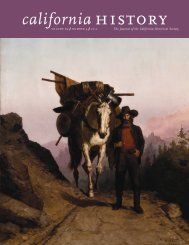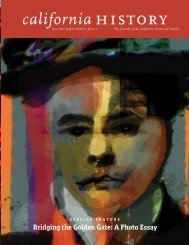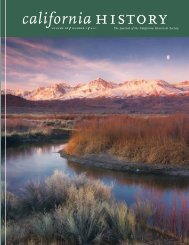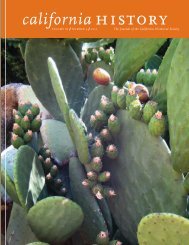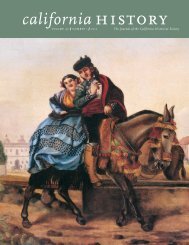participation in any previous student referendum.The results revealed that an overwhelming85 percent of the students favored “preservationof the land currently known as People’s Park as itwas prior to May 12.” 52Additionally, a total of eighty-four leaders ofmainstream student organizations—includingthe editor of the yearbook, the president of theInterfraternity Organization, the senior classpresident, the chairman of Big Game Week,and the leaders of the Pom-Pom Girls and OshiDolls—signed a letter to the nonradical campusnewspaper, the Daily <strong>California</strong>n, calling for “thespontaneous and continued development ofthat park area” under the control of “those studentsand members of the community by whomthe park was initially developed and creativelydesigned.” On May 23, UC’s Faculty Senate votedoverwhelmingly, 642–95, in favor of a resolutionurging removal of the fence and also callingfor the attorney general to investigate “policeand military lawlessness committed . . . in thename of maintaining law and order.” On May 25,Reagan partly relented, rescinding the curfewand his edict prohibiting public assembly. Healso removed most National Guardsmen to theirarmories and reduced their role from patrollingthe streets to protecting the fence aroundPeople’s Park and the Hall of Justice. 53With civil liberties now fully restored, the causeof People’s Park drew tens of thousands to apair of peaceful marches. On May 26, 7,500marched to the state capitol and on MemorialDay an estimated 20,000 to 30,000 marchedpast People’s Park without incident. Rejecting thedisruptive street tactics that had been in voguesince Stop the Draft Week, the event representeda return to the nonviolent protests of the FreeSpeech Movement and the early days of theantiwar movement. Protesters employed creativetactics, such as laying sod on the pavement ofBerkeley streets. 54The peaceful nature of the Memorial Day marchobviously influenced Reagan. Responding onJune 2, the governor withdrew the NationalGuard and Bay Area police, including SheriffMadigan and his “Blue Meanies.” In addition, herevoked the “state of extreme emergency” that hehad declared nearly four months earlier. 55Chancellor Heyns now finally recognized anexpanding coalition of park supporters. Althoughhe still opposed the Van der Ryn proposal, hebacked a new compromise, approved by a 5–4Berkeley City Council vote, providing that a portionof Lot 1875-2 be leased to the city of Berkeleyand developed as a community-used anduser-developed park. In addition to Heyns, theplan had the support of 81 percent of area residents,according to the College of EnvironmentalDesign survey; 85 percent of students, accordingto the student referendum; 87 percent of the faculty,according to the Faculty Senate resolution;Berkeley Mayor Wallace Johnson; the BerkeleyCity Council; and the president of the nine-schoolUC system, Charles J. Hitch. 56Significantly, the widely popular proposal was notacceptable to Governor Reagan, who thought hehad backed down far enough by halting the militaryresponse to the protests. Reagan adamantlyrefused to make any concessions on People’sPark, maintaining that conceding in the past hadled to Bloody Thursday and the death of JamesRector: “The police didn’t kill the young man.He was killed by the first college administratorwho said some time ago it was all right to breakthe law in the name of dissent.” According to thegovernor, compromise on People’s Park would“appear as nothing but a cop-out” or “anotherconcession and roundabout way of giving this tothe people who tried to take it by force.” For Reagan,the course of action was simple: “We boughtthis land for $1.3 million for a specific use.” If theuniversity failed to develop the lot along the linesof the ten-year plan, then the governor suggested“we couldn’t show our faces to the taxpayers of<strong>California</strong> History • volume 88 number 1 2010
this state.” On June 20, Reagan thwarted thespirit of compromise at a meeting of the Regents,which rejected the new plan by a vote of 18–6and endorsed Reagan’s position by approving,16–7, a resolution to construct married-studentapartments “as expeditiously as possible.” 57Reagan had emerged victorious in the battle forPeople’s Park. His assertion of university propertyrights was politically popular on state andnational levels with voters who had grown wearyof campus disruptions. William J. McGill noted:“Whenever Governor Reagan attacked the Universityof <strong>California</strong>, his popularity zoomed.” Reagan,with his antipark position, endeared himselfto his mentor, FBI Director J. Edgar Hoover, andto the conservative wing of the Republican Party,whose support ultimately took him all the way tothe White House. Reagan definitely got what hewanted from People’s Park. 58Epilogue: SurvivalOn the local scene, Berkeley radicals, who hadproclaimed in a pro-park leaflet “We need thepark to live and grow and eventually we need allof Berkeley,” also got what they wanted. Madiganand Reagan, by overreacting to People’s Park,destroyed conservative influence in Berkeley,paving the way for a radical takeover. In the1971 Berkeley elections, radicals won four seatson the City Council and controlled the mayor’soffice under Warren Wideman. Chancellor Heynsresigned the same year. One year later, a groupof activists tore down the hated fence that hehad constructed. The park was reclaimed, albeitwithout the imaginative architectural designs thathad marked the original project. However, thenew park was no longer limited to the northeastcorner of the lot, since all three acres were nowliberated as open space. 59People’s Park has survived the interveningdecades, despite periodic threats from the university.In 1979, the university tried to lay claimto a no-cost parking lot on the park’s westernend and turn it into a fee lot for students andfaculty. Protesters tore up the asphalt, pitchedtents, and maintained a twenty-four-hour vigil.The university surrendered, and park defenderstransformed the section into an organic gardeningarea that thrives today. Throughout the firsthalf of the 1980s, the university simply sniped atuser attempts to develop the park. For example,after allowing the construction of a wooden bandstand,the People’s Stage, in 1978, the universitybanned amplified music two years later. Whenpark users planted trees and installed benches,campus police uprooted and removed them. 60People’s Park again emerged at the forefrontof controversy in 1989. When Chancellor IraMichael Heyman complained that the park wasa haven for drug dealers and the homeless, theuniversity announced plans to build a 200-beddormitory on the site. Mayor Loni Hancock,one of four radicals elected to the Berkeley CityCouncil in 1971, blocked its construction, and awar of words ensued that ended with the signingof an accord between the university and thecity in October 1989. The university shelved itsplans for dormitory construction and agreed that“People’s Park should be retained as open space.”Veteran activists, though, were dismayed that theuniversity still claimed “a portion of the space” tobe “developed and maintained by the Universityfor informal recreation use (e.g.: volleyball andbasketball).” 61Their fears were confirmed on July 31, 1991,when bulldozers arrived to build sand volleyballcourts at the southern end of the park. Constructionof the volleyball courts coincided with theenforcement by campus police of the park’s10 p.m. curfew, preventing the homeless fromsleeping in the park. Protesters rioted for twelvedays. The underlying issues of this conflict,however, went far beyond volleyball courts. DonMitchell, a professor of geography at the Universityof Syracuse, has described the 1991 People’s7
- Page 3: california historyvolume 88 number
- Page 6 and 7: c o l l e c t i o n sAdmission tick
- Page 8 and 9: c o l l e c t i o n sBusiness cards
- Page 10 and 11: People’s Park:Birth and SurvivalB
- Page 12 and 13: even on existing dorms due to the h
- Page 14 and 15: The attraction, however, was fleeti
- Page 16 and 17: Bay Area—North Beach and Haight-A
- Page 18 and 19: A hundred students, activists, and
- Page 20 and 21: are building a park on the land. We
- Page 22 and 23: and illegal drug use in the park. T
- Page 24: without even allowing Siegel to con
- Page 27: As Bloody Thursday came to a close,
- Page 31 and 32: Denovo, her autopsy revealed a down
- Page 33 and 34: ation and encouragement, and shed n
- Page 35 and 36: the guardians of her children. The
- Page 37 and 38: mitted to visit Caroline in her new
- Page 39 and 40: Sojourner Truth gave what famously
- Page 41 and 42: After emancipation, she helped to o
- Page 43 and 44: This 1885 view captures the sparsel
- Page 45 and 46: But Caroline thought it imprudent t
- Page 47 and 48: The “Mother of Clubs”In Boston,
- Page 49 and 50: Caroline attended the September 189
- Page 51 and 52: ments, Seymour and Sibley earned pe
- Page 53 and 54: In this photograph, San Francisco s
- Page 55 and 56: n o t e s12People’s Park: Birth a
- Page 57 and 58: 1969; McGill, The Year of the Monke
- Page 59 and 60: that “thousands of the brightest
- Page 61 and 62: For Both Cross andFlag: Catholic Ac
- Page 63 and 64: d o n o r sThe California Historica
- Page 65 and 66: In Kind DonationsSandy Alderson, Sa
- Page 67: Membership BenefitsJoin tHeCaliforn



